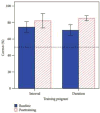Voice emotion perception and production in cochlear implant users
- PMID: 28088500
- PMCID: PMC5937709
- DOI: 10.1016/j.heares.2017.01.006
Voice emotion perception and production in cochlear implant users
Abstract
Voice emotion is a fundamental component of human social interaction and social development. Unfortunately, cochlear implant users are often forced to interface with highly degraded prosodic cues as a result of device constraints in extraction, processing, and transmission. As such, individuals with cochlear implants frequently demonstrate significant difficulty in recognizing voice emotions in comparison to their normal hearing counterparts. Cochlear implant-mediated perception and production of voice emotion is an important but relatively understudied area of research. However, a rich understanding of the voice emotion auditory processing offers opportunities to improve upon CI biomedical design and to develop training programs benefiting CI performance. In this review, we will address the issues, current literature, and future directions for improved voice emotion processing in cochlear implant users.
Keywords: Cochlear implant; Speech prosody; Voice emotion; Voice emotion perception; Voice emotion production.
Copyright © 2017 Elsevier B.V. All rights reserved.
Conflict of interest statement
Figures






Similar articles
-
Musical and vocal emotion perception for cochlear implants users.Hear Res. 2018 Dec;370:272-282. doi: 10.1016/j.heares.2018.08.009. Epub 2018 Aug 25. Hear Res. 2018. PMID: 30181063
-
Voice emotion recognition by cochlear-implanted children and their normally-hearing peers.Hear Res. 2015 Apr;322:151-62. doi: 10.1016/j.heares.2014.10.003. Epub 2014 Oct 16. Hear Res. 2015. PMID: 25448167 Free PMC article.
-
Period for Normalization of Voice Acoustic Parameters in Indian Pediatric Cochlear Implantees.J Voice. 2017 May;31(3):391.e19-391.e25. doi: 10.1016/j.jvoice.2016.09.030. Epub 2016 Oct 28. J Voice. 2017. PMID: 28029557
-
Vocal control and speech production in cochlear implant listeners: A review within auditory-motor processing framework.Hear Res. 2024 Nov;453:109132. doi: 10.1016/j.heares.2024.109132. Epub 2024 Oct 18. Hear Res. 2024. PMID: 39447319 Review.
-
Importance of cochlear health for implant function.Hear Res. 2015 Apr;322:77-88. doi: 10.1016/j.heares.2014.09.009. Epub 2014 Sep 28. Hear Res. 2015. PMID: 25261772 Free PMC article. Review.
Cited by
-
Parental Competence as a Teacher in the Auditory Development of Children with Cochlear Implants.J Psycholinguist Res. 2023 Dec;52(6):2119-2133. doi: 10.1007/s10936-023-09995-8. Epub 2023 Jul 22. J Psycholinguist Res. 2023. Retraction in: J Psycholinguist Res. 2025 Apr 12;54(2):25. doi: 10.1007/s10936-025-10131-x. PMID: 37480449 Retracted.
-
Multimodal and Spectral Degradation Effects on Speech and Emotion Recognition in Adult Listeners.Trends Hear. 2018 Jan-Dec;22:2331216518804966. doi: 10.1177/2331216518804966. Trends Hear. 2018. PMID: 30378469 Free PMC article.
-
Effects of mild-to-moderate sensorineural hearing loss and signal amplification on vocal emotion recognition in middle-aged-older individuals.PLoS One. 2025 Jul 16;20(7):e0322867. doi: 10.1371/journal.pone.0322867. eCollection 2025. PLoS One. 2025. PMID: 40668811 Free PMC article.
-
Investigation of Deficits in Auditory Emotional Content Recognition by Adult Cochlear Implant Users through the Study of Electroencephalographic Gamma and Alpha Asymmetry and Alexithymia Assessment.Brain Sci. 2024 Sep 17;14(9):927. doi: 10.3390/brainsci14090927. Brain Sci. 2024. PMID: 39335422 Free PMC article.
-
Children's Neural Sensitivity to Prosodic Features of Natural Speech and Its Significance to Speech Development in Cochlear Implanted Children.Front Neurosci. 2022 Jul 12;16:892894. doi: 10.3389/fnins.2022.892894. eCollection 2022. Front Neurosci. 2022. PMID: 35903806 Free PMC article.
References
-
- Andrews FM, Diehl NC. Development of a technique for identifying elementary school children’s musical concepts. J Res Music Ed. 1970;18:214–222.
-
- Apple W, Streeter LA Krauss RM. Effects of pitch and speech rate on personal attributions. J Pers Soc Psychol. 1979;37:715–27.
Publication types
MeSH terms
Grants and funding
LinkOut - more resources
Full Text Sources
Other Literature Sources
Medical
Research Materials

